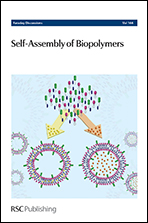Self-assembly of biomolecular soft matter
Abstract
Self-assembly programmed by molecular structure and guided dynamically by energy dissipation is a ubiquitous phenomenon in biological systems that build functional structures from the nanoscale to macroscopic dimensions. This paper describes examples of one-dimensional self-assembly of peptide amphiphiles and the consequent biological functions that emerge in these systems. We also discuss here hierarchical self-assembly of supramolecular peptide nanostructures and polysaccharides, and some new results are reported on supramolecular crystals formed by highly charged peptide amphiphiles. Reflecting on presentations at this Faraday Discussion, the paper ends with a discussion of some of the future opportunities and challenges of the field.
- This article is part of the themed collection: Self-Assembly of Biopolymers

 Please wait while we load your content...
Please wait while we load your content...